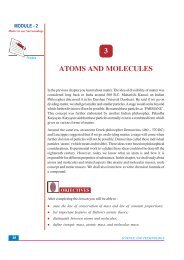NIOS : The Way Forward - The National Institute of Open Schooling
NIOS : The Way Forward - The National Institute of Open Schooling
NIOS : The Way Forward - The National Institute of Open Schooling
You also want an ePaper? Increase the reach of your titles
YUMPU automatically turns print PDFs into web optimized ePapers that Google loves.
<strong>NIOS</strong>: <strong>The</strong> <strong>Way</strong> <strong>Forward</strong> / 29<br />
A basic feature <strong>of</strong> the ODL system is its flexibility and readiness to adapt to<br />
suit the needs <strong>of</strong> the learner to the extent possible. In ODL system, emphasis<br />
is given to open secondary and open senior secondary courses but also to<br />
open elementary education and vocational education. ODL system should<br />
also put great emphasis on life enrichment courses as well as on development<br />
<strong>of</strong> life skills.<br />
3.3 Spiral and Linear Organization<br />
In the conventional system, Curriculum contents are generally organized in<br />
linear and sequential manner, one learning point leading to another. This<br />
sequence is built up from stage to stage and grade to grade. In modern practice,<br />
instead <strong>of</strong> linear organization, it has been found to be better to organize the<br />
contents spirally. <strong>The</strong> strength <strong>of</strong> the spiral approach is that it starts with the<br />
core concept at the beginning and then gradually evolves it into finer details<br />
and branches <strong>of</strong>f, making the content deeper and wider at each stage. This<br />
increases the level <strong>of</strong> understanding and as a result, students are more<br />
empowered to make practical applications in life.<br />
Curricular Contents become meaningful when they are organized contextually.<br />
Knowledge remains bookish and verbal and cannot be fully assimilated, unless<br />
it is concretized and connected to life contexts. Similarly abstract knowledge<br />
can easily be assimilated if concrete examples are given and contextualized<br />
with social reality. It is therefore, very essential that the content <strong>of</strong> learning<br />
should be contextualized, concretized and illustrated. <strong>The</strong>se concerns are<br />
kept in mind, when <strong>NIOS</strong> develops its curriculum and course material.<br />
<strong>Open</strong> Education has been a green house <strong>of</strong> educational innovations. <strong>The</strong><br />
flexible scheme <strong>of</strong> studies and evaluation which emerged with ODL system<br />
has now been recognized by face-to-face conventional system also. <strong>The</strong><br />
modular approach <strong>of</strong> ODL system was also seen as an advance over the<br />
normal textbook lessons. <strong>The</strong> contents <strong>of</strong> ODL system have always followed<br />
a stage-wise approach. In open basic education curriculum contents are not<br />
divided class wise. This approach has been duly recognized in NCF 2005.<br />
3.4 Curriculum Development Design<br />
Course planning-design-development-despatch is a long process, and the<br />
long time taken between the initiation and the production <strong>of</strong> the printed material<br />
is because <strong>of</strong> the several stages that the course units pass through (See Fig.<br />
3.1)

















